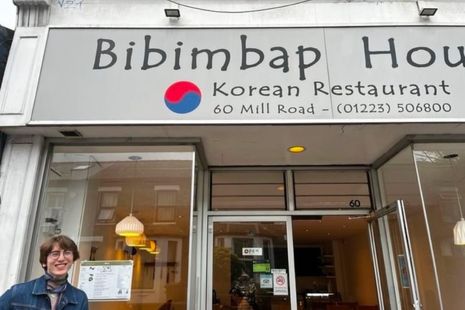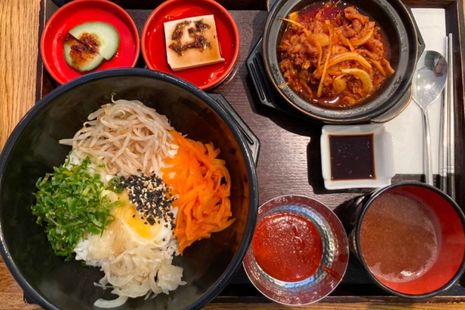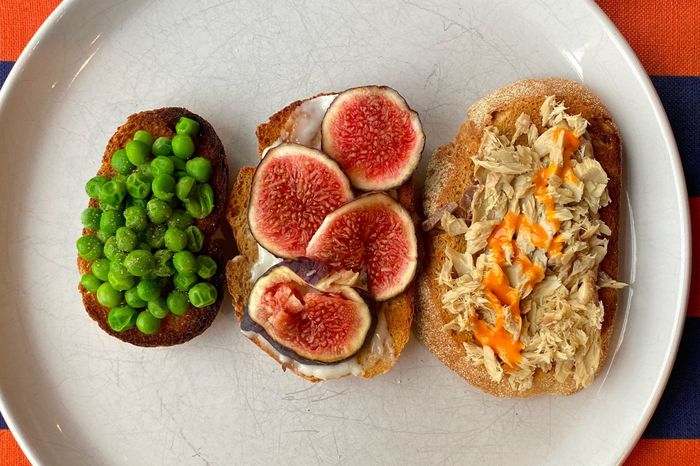Bibimbap House: the best Korean food in Cambridge
Leo Kang urges you not to follow the crowd to Yori, but head on down to Bibimbap House

Growing up, I remember my mother would never let leftovers go to waste. Old, gnarly carrots, wilting spinach, or thinly sliced steak – anything could be added to a wok with rice and soy sauce and refried until fragrant. It was all served piping hot in a bowl and crowned with a crispy fried egg, which I broke up with my spoon, turning the whole thing glossy and golden. My mother would call the dish ‘bibimbap’: literally, ‘mixed rice’.
The bibimbap of my childhood was a slapdash affair – a convenient breakfast, and a blank canvas to mess with as we saw fit. Restaurant bibimbaps, I later realised, were much more delicate – pristine puddles of marinated meat and veg, perched atop beds of buoyant, fluffy rice.
“The delight is in the DIY – mixing your own meal feels slightly magical”
Whatever form it takes, a bibimbap should be a nourishing, all-in-one experience. The delight is in the DIY – mixing your own meal feels slightly magical, and there’s even a specific way of doing it (fold in from the outside and smush down in the centre, if you’re interested).
If you want somewhere in Cambridge to hit at the homely heart of the bibimbap – to fill your stomach as well as your camera roll – you’ll have to trot on down to Bibimbap House.
Two things to be gleaned from the name. Firstly, they make one thing – bibimbap – and they make it well. Secondly, they feel more like a house than a restaurant. I have no problems with K-Pop decor, where Korean businesses plaster polaroids of superstars across their walls (‘if it’s good enough for Jennie from Blackpink, it’s good enough for you! ’). Still, there’s none of that here. A beaded curtain is all that separates us from the kitchen – peering in, I see ajummas (basically the Korean version of South Asian ‘aunties’) bustling to and fro with steaming cast iron pots. In the dining room the walls are bare, save for the menu, scratched on a blackboard, as well as a few dangling norigae – colourful pendants with silky tassels. I used to have loads in my bedroom. They’re traditional good-luck charms, and they bode well for the upcoming meal.

The room itself is small but spacious, with sturdy wooden tables and one long counter. The front doors and windows are glass: a haven for people watchers. As evening approaches, the restaurant is warmed by rosy light and the steady buzz of Mill Road from outside. Unfortunately, my blasé attitude towards booking has landed me and half the Varsity editorial team on the counter, facing the wall. Chatting requires us to crack our neck muscles in unsettling ways. If you’re coming as a group, I’d recommend phoning in advance.
Though bibimbap is the only main dish on the menu, we do order some sides. The kimbap – a kind of heartier sushi – is top notch and comes with a surprise sprinkle of crackly fried onions. The bean curd pockets are crispy on the outside and stuffed with moist shreds of veg and beef. I also treat myself to a refreshing can of sujeonggwa (cinnamon punch) to ring in the autumn.
“Scooping it up and slathering it over the rice is so fun I almost feel self-conscious to be doing it in public”
As for the bibimbap itself … it’s really, really good. I get the pork bulgogi bibimbap, and the toppings are humble, traditional options: beansprouts, spring onions, carrots, and, of course, an egg. The veg is fantastically firm and fresh, but the real star of the show is the pork. In a unique addition, it’s served sizzling hot in a separate bowl. Scooping it up and slathering it over the rice is so fun I almost feel self-conscious to be doing it in public. The thin shavings are perfectly tender, and the flavour is fiery with a savoury sucker punch.
The special thing about this place is that every rice bowl comes as a meal set: a tray of tasty treats. Customisation is encouraged with saucers of gochujang and soy sauce. The gochujang is, in my opinion, essential. The soy sauce less so – the dish is already well seasoned – but I do love that it’s there. The other treats are slimmed down versions of traditional side dishes. There’s a welcome nod to kimchi: a cucumber slice rubbed with red pepper flakes, soy sauce, and sesame seeds, then cut to resemble a love heart. There’s also a tofu slice marinated in doenjang: a dark soybean paste and the earthier, funkier cousin to miso. Then, there’s a bowl of doenjang soup. This is a staple accompaniment to almost every meal in Korea. I can only describe its taste as being like a big hug. When I’ve polished off my bibimbap, I slurp it down, and my stomach rumbles contentedly.
As far as I’m concerned, this is the best Korean food in Cambridge. It’s also the most authentic. With the meal sets, Bibimbap House manages to hint at the warmth of a Korean dining experience – where plates are piled high, and the side dishes keep flowing until everyone is stuffed – while remaining sustainable as an English restaurant. At £15-17.50 for a bibimbap and £8 for a side, it’s certainly not somewhere I’ll be eating every week. In terms of value, though, you get what you pay for. Next time you’re thinking of forking out £12 for a pancake at Yori, consider making the trek down to Mill Road instead.
 Comment / Cambridge students are too opinionated 21 April 2025
Comment / Cambridge students are too opinionated 21 April 2025 Interviews / Meet the Chaplain who’s working to make Cambridge a university of sanctuary for refugees20 April 2025
Interviews / Meet the Chaplain who’s working to make Cambridge a university of sanctuary for refugees20 April 2025 News / News in brief: campaigning and drinking20 April 2025
News / News in brief: campaigning and drinking20 April 2025 Comment / Cambridge’s tourism risks commodifying students18 April 2025
Comment / Cambridge’s tourism risks commodifying students18 April 2025 Comment / Cambridge’s gossip culture is a double-edged sword7 April 2025
Comment / Cambridge’s gossip culture is a double-edged sword7 April 2025






